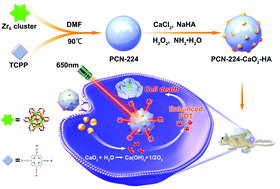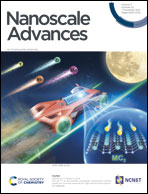Metal–organic framework combined with CaO2 nanoparticles for enhanced and targeted photodynamic therapy†
Abstract
Photodynamic therapy (PDT) has been rapidly developed as an effective therapeutic approach in clinical settings. However, hypoxia seriously limits the effectiveness of PDT. Here, we report a porphyrin-based metal–organic framework combined with hyaluronate-modified CaO2 nanoparticles (PCN-224-CaO2-HA) to target and enhance PDT efficacy. CaO2 reacts with H2O or weak acid to produce O2, overcoming the hypoxia problem. Hyaluronate protects CaO2 and specifically targets the CD44 receptor, which is highly expressed on tumor cell membranes, performing targeted therapy. After PDT treatment in vitro, the survival rates of 4T1 and MCF-7 tumor cells were 14.58% and 22.45%, respectively. The fluorescence imaging showed that PCN-224-CaO2-HA effectively aggregated in the tumor after 12 h of its intravenous injection into tumor-bearing mice. PCN-224-CaO2-HA exhibited efficacious tumor growth inhibition via enhanced PDT. Overall, this nanosystem providing in situ oxygen production was successfully used for targeted PDT with a significantly enhanced therapeutic efficacy in vitro and in vivo.

- This article is part of the themed collections: Advanced Functional Nanomaterials for Biomedical Applications and Popular Advances


 Please wait while we load your content...
Please wait while we load your content...